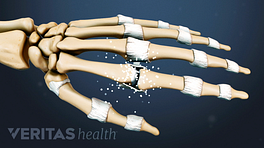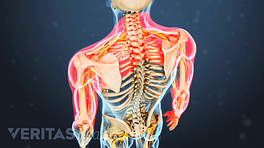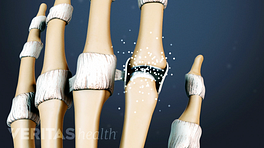There are many conditions related to inflammatory arthritis. Some conditions exhibit symptoms similar to those of inflammatory arthritis, some are autoimmune disorders that can result from inflammatory arthritis, and some occur in conjunction with inflammatory arthritis.
In This Article:
- Types of Arthritis
- Degenerative Arthritis
- Conditions Related to Degenerative Arthritis
- Inflammatory Arthritis
- Conditions Related to Inflammatory Arthritis
- Adhesive capsulitis – also known as “frozen shoulder,” the connective tissue surrounding the joint becomes stiff and inflamed causing extreme pain and greatly restricting movement.
- Adult onset Still’s disease – a form of arthritis characterized by high spiking fevers and a salmon-colored rash. Still’s disease is more common in children.
- Caplan’s syndrome – an inflammation and scarring of the lungs in people with rheumatoid arthritis who have exposure to coal dust, as in a mine.
- Carpal tunnel syndrome – a painful progressive condition caused by compression of the median nerve in the wrist. People with rheumatoid arthritis are at increased risk of developing carpal tunnel syndrome.
Watch: Carpal Tunnel Syndrome Video
- Celiac disease – an autoimmune disorder of the small intestine that causes malabsorption of nutrients and can eventually cause osteopenia or osteoporosis.
- Chronic recurrent multifocal osteomyelitis – a rare childhood disease involving swelling of bones of the arms, legs, and collarbone. It is an inherited auto-inflammatory disorder that may also be considered an autoimmune disease.
- Chronic synovitis – a general term describing diseases involving joint inflammation in children.
- Complex regional pain syndrome – a chronic progressive disease characterized by severe pain and swelling. While it can cause osteoporosis, the condition is also believed to have an immunological component.
- Costosternal syndrome – a painful inflammation of the intercostal cartilage connecting the ribs to the sternum. Sometimes referred to as Costochondritis or Tietze syndrome (if accompanied by swelling).
- Cryoglobulinemia – the presence of abnormal protein molecules in the blood causing circulation problems to the extremities, especially at low temperatures.
advertisement
- Dermatomyositis – a connective tissue disease characterized by inflammation of the muscles and the skin. The condition is believed to be caused either by viral infection or an autoimmune reaction.
- Diabetic finger sclerosis – a complication of diabetes, causing a hardening of the skin and connective tissue in the fingers, thus causing stiffness.
- Duchenne muscular dystrophy – one of the most prevalent types of muscular dystrophy, characterized by rapid muscle degeneration.
- Dupuytren’s contracture – an abnormal thickening of tissues in the palm and fingers that can cause the fingers to curl.
- Eosinophilic fasciitis (Shulman’s syndrome) – a condition in which the muscle tissue underneath the skin becomes swollen and thick. People with eosinophilic fasciitis have a build up of eosinophils—a type of white blood cell—in the affected tissue. Some patients also develop arthritis.
- Familial Mediterranean fever – an inherited auto inflammatory disorder characterized by recurrent episodes of fever and inflammation of the abdominal membrane.
- Felty syndrome – a form of RA with fever and many other symptoms including weight loss, recurrent infections, peripheral neuropathy, and carpal tunnel syndrome, among others.
- Fibromyalgia – a widespread musculoskeletal pain and fatigue disorder. Twenty to thirty percent of patients with RA and systemic lupus erythematosus may also have fibromyalgia.
- Giant cell/Temporal arteritis – a condition involving swelling of the arteries in the head, neck, and arms, reducing blood flow. This condition often accompanies polymyalgia rheumatica.
- Goodpasture’s syndrome – a disease in which the immune system makes antibodies targeted to attack the lungs and kidneys.
- Hemochromatosis –an inherited disorder that causes the body to absorb and store excessive amounts of iron. Arthritis can result from the build up of iron.
- Hypertrophic osteoarthopathy – a syndrome causing clubbing of the fingers and toes, enlargement of the extremities, and painful swollen joints. The condition is caused secondary to lung disease or bacterial infection.
- Immune complex disease – a condition characterized by the formation of immune complexes—clusters of interlocking antigens and antibodies. In some cases, they become trapped in the tissues of the body setting off reactions that cause inflammation and tissue damage.
- Inflammatory Bowel Disease (including ulcerative colitis and Crohn’s) – a group of inflammatory conditions of the colon and small intestine. Arthritis is a common complaint of people with IBD.
- Juvenile rheumatoid arthritis – arthritis that causes joint inflammation and stiffness in a child of 16 years of age or less. Any joint can be affected, and inflammation may greatly limit mobility.
- Jaccoud’s arthropathy – a joint disease that occurs after rheumatic fever, often in the hands and feet. The condition can also occur alongside rheumatoid arthritis or lupus.
- Kawasaki disease – a disease affecting the lymph nodes of the immune system and other parts of the body, with the greatest affect on the blood vessels.
- Löfgren’s syndrome – the association of swollen lymph tissue and small, painful, red nodules under the skin with joint pain.
- Malignant synovioma – a cancerous tumor that develops in tendon and joint tissues.
- Mixed connective tissue disease (MCTD) – overlapping connective tissue disorders—including systemic lupus erythematosus, polymyositis, and scleroderma—that cannot be diagnosed more specifically. There are often arthritic manifestations of these disorders.
- Multicentric reticulohistiocytosis – a rare systemic disease in which cells grow out of control and are destructive to joint and skin tissues.
- Nodular panniculitis (Weber-Christian disease) – a skin condition featuring recurring inflammation of the fat layer of the skin. Fatigue, fever, and joint pain frequently occur.
- Overlap syndrome – a term used to describe when sclerosis (thickening or hardening of tissues) appears in association with features of other connective tissues diseases including systemic lupus erythematosus, polymyositis, or dermatomyositis.
- Palindromic rheumatism – a rare type of inflammatory arthritis characterized by recurrent attacks of painful swelling of the joints and surrounding tissues.
- Polychondritis – a chronic disorder of the cartilage characterized by recurrent episodes of inflammation, believed to be caused by an immune system disorder. Commonly affected sites include the ears, nose, joints, spine, and trachea.
- Polymyalgia rheumatica – a rheumatic disorder associated with moderate to severe muscle pain and stiffness, most commonly in the neck, shoulders, and hips. Patients often experience fatigue, mild fever, and an overall feeling of illness.
- Polymyositis – a disease of the muscle featuring inflammation of the muscle fibers. Though the cause of the disease is unknown, it begins when immune cells spontaneously invade seemingly healthy muscles.
- Raynaud’s phenomenon – a condition resulting from poor circulation in the extremities. It occurs secondary to many inflammatory connective tissue diseases.
- Restless leg syndrome (RLS) – the irresistible urge to move the body to stop uncomfortable sensations. RLS is often associated with autoimmune disorders such as Sjögren’s syndrome, celiac disease, and rheumatoid arthritis.
- Sarcoidosis – a disease causing inflammation of the body’s tissues along with small bumps called nodules or granulomas.
- Scleroderma – a group of diseases involving the abnormal growth of connective tissue supporting the skin and internal organs. Hardened skin can cause pain and stiffness in the joints.
- CREST syndrome
- Linear scleroderma
- Seronegative arthritis – inflammatory arthritis in which antibodies usually present are missing from the blood, making it difficult to diagnose a specific rheumatic condition like rheumatoid arthritis or lupus. Once time has passed and other diagnoses can be ruled out, this condition is typically diagnosed as rheumatoid arthritis.
advertisement
- Sweet’s syndrome – a skin disease characterized by sudden fever, painful, scaly patches of skin, and an increase in white blood cells. Symptoms often include headache and joint pain.
- Sjögren’s syndrome – an autoimmune disease characterized by excessive production of antibodies directed to attack tissues throughout the body. It often occurs along with rheumatoid arthritis.
- Tarsal tunnel syndrome – an entrapment of the tibial nerve running the length of the leg to the inside of the ankle. Pressure placed on the tendon, such as inflammation or swelling from RA, puts patients at increased risk for this problem.
- Traumatic arthritis – joint disease resulting from direct or indirect injury to the joint. During the healing process, bones and other structures may grow abnormally causing friction and damage in the joint space.
- Undifferentiated connective tissue disease – a term used to describe patients who exhibit features strongly suggestive of connective tissue disease, but unable to be diagnosed as a specific disorder.
advertisement











